Trentino-Alto Adige
Ledro Land Art, the forest in Trentino where art meets nature
In the Ledro Valley, in a beautiful fir forest, the Ledro Land Art project, a park where art, made entirely from local natural materials, meets nature, has come to life a few years ago.
By Ilaria Baratta
| 04/09/2021 16:29
When art meets nature it is able to give life to enchanting places, such as Ledro Land Art: a widespread exhibition path in the middle of a forest that allows lovers of walks in the green to linger and admire contemporary art installations in clear harmony with the surrounding environment. In fact, all the works that one encounters along the loop trail to be walked in complete peace and quiet, accompanied by the sweet song of the birds chirping among the foliage of the tall trees typical of the local vegetation, are made solely of natural materials, mainly wood, an element that is fully part of the concept, never more relevant than at this most current moment, of sustainability and that is deeply linked to the region in which the park is located. In fact, Trentino-Alto Adige is the region in Italy where the most wood is produced, thanks to the many forests and the many dense woodlands in the area: among the main types of wood in Trentino are larch, Scotch pine and spruce. Along with the birdsong, it is not uncommon to hear, as happened to the writer, the bleating of sheep and the jingling of the bells that these animals have hanging around their necks, first of all because in the vicinity one can reach many malghe, the buildings used for sheltering animals in the summer and for the production of milk and cheese, and secondly because sheep are very greedy for grass and therefore act as natural "grass cutters."
Ledro Land Art stretches through the pine forest of Pur, one of the green lungs of the Ledro Valley in southern Trentino: a path along the Assat stream leads to the Malga Cita and inside the pine forest, where contemporary artists are invited each year in the summer season to make site-specific interventions directly on site, reinterpreting the natural space.
Although the whole path along the art park is overall very pleasant and in full harmony with the environment, to tell the truth, it is inevitable to be fascinated by some works compared to others, as they are larger in size and more suggestive. First of all, Franz Avancini's Monkey, created in 2019 in collaboration with the boys of the Smarmellata association during a workshop dedicated to Land Art. The monumental sculpture is made entirely of wood and the outer part of straw, to give the impression of the animal's fur. Of the latter, only the snout and the two large upper limbs are depicted, as if only part of the body emerged from the ground; with one hand it holds firmly to the trunk of a tree, while the other rests severely on the earth, a device that fully expresses the sense of belonging to the place and the desire to reflect on the protection of the park and nature in a broader sense. By the same authors is another large animal, specifically an amphibian, placed right on the Assat River: it is an alpine newt, similar to a salamander, which has just emerged from the water, turning its gaze westward. It is a collective work created in 2020 by Franz Avancini with the Smarmellata association and with the support of Piano B; the newt is made up of about four thousand wooden "circles" and 540 rods for the structure that supports the whole thing, and the choice to shape this animal is due to the fact that it is endangered and is very sensitive to pollution, thus fully in line with the project aimed at sustainability.
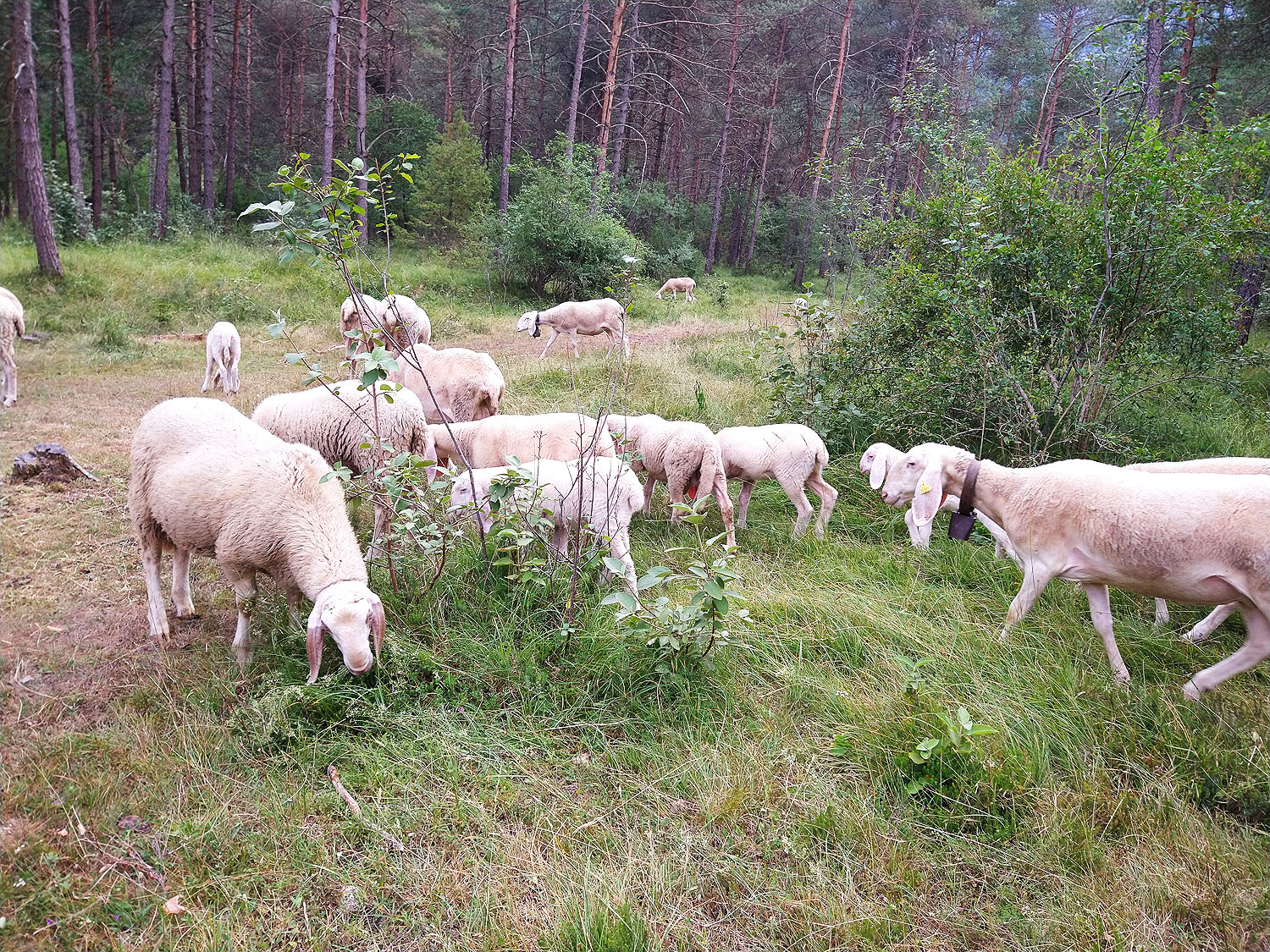 |
| Sheep in Ledro Land Art Park |
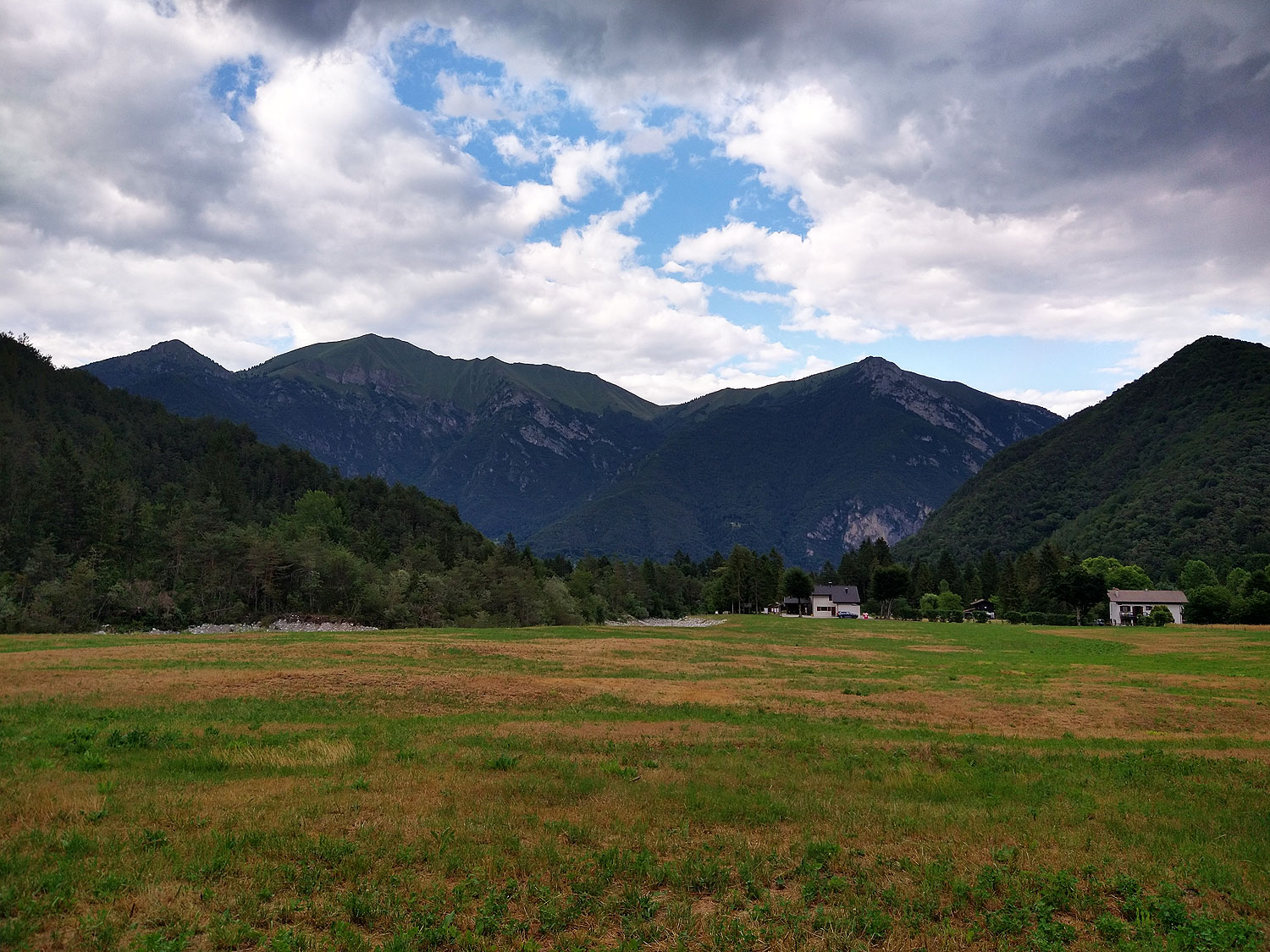 |
| The landscape around Ledro Land Art |
The monkey and the alpine newt are not the only animals that can be encountered along the Ledro Land Art trail: in fact, they are joined by the Snail, the Hedgehog, cows and chickens. The first one was made by Corrado Rosa in 2012 with the use of old rusty irons, bent and welded together: it is caught at the moment when, passing a boulder, it is heading toward the water of the stream not far from there. It is a tribute to the snails whose "little houses" glide over the grass and earth, leaving their path visible through the transparent, sticky trail they produce. The Hedgehog , on the other hand, is the work of Giampaolo Osele: the artist made it in 2014 using larch, hazel and laburnum woods. Stylized in form, the little animal with the cute pointed snout meets visitors to the pine forest to tell the simple and naive aspect of nature as a generating energy and source of inspiration. However, one cannot leave the park (and Trentino) without first seeing the cows in the alpine pasture: so here Paolo Vivian has gathered a herd of cows made of stone boulders and iron pieces. Cow show, this is the title of the 2012 work, is meant to be a reflection on the forms of nature and their material and figurative correspondences: from simple stone boulders to create the muzzle and body and from pieces of iron to create the cow's horns, Vivian makes recognizable forms that would otherwise have gone unnoticed. As a symbol of changing times and local traditions that are increasingly disappearing, Matteo Cretti has instead created a rooster and four chickens pecking the ground free and not on intensive farms, where poultry are forced to be crowded together and in perpetual light. Sign o' the times, that's the title, is meant to reflect on a changing world in which man transforms and conditions the planet with harmful consequences: it is a call to protect traditions and return to rurality for a world closer to nature.
Going in order, Ledro Land Art 2021's diffuse path consists of twenty-seven works: it opens Rave by Erika Inger (2019), a work that represents in essential forms a swarm of insects to denounce the death of insects due to the massive use of fertilizers and pesticides. The artist dedicates his work to the people of Malles, South Tyrol, who aim to pursue sustainable, pesticide-free agriculture. It continues with a tribute to the Xennials generation, as defined by Australian sociologist Dan Woodman, or those born between 1977 and 1983. Xennials trib ute is in fact a cassette tape made from reclaimed larch wood and the tin gutter of a postwar barn to shape the tape; hanging among the trees, it has a large pencil inserted in one of the two holes that were used to rewind the tape.
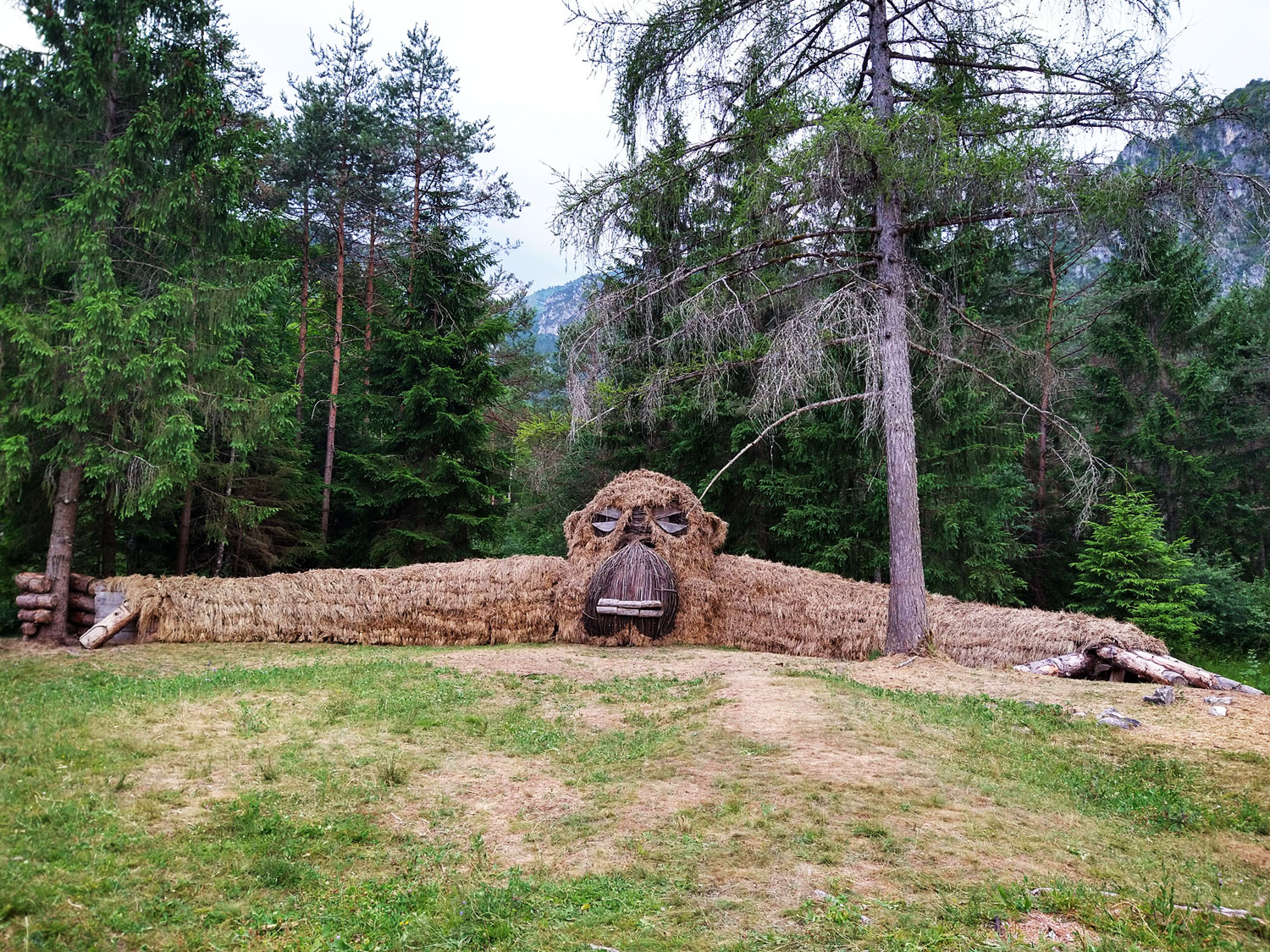 |
| Franz Avancini, Monkey (2019) |
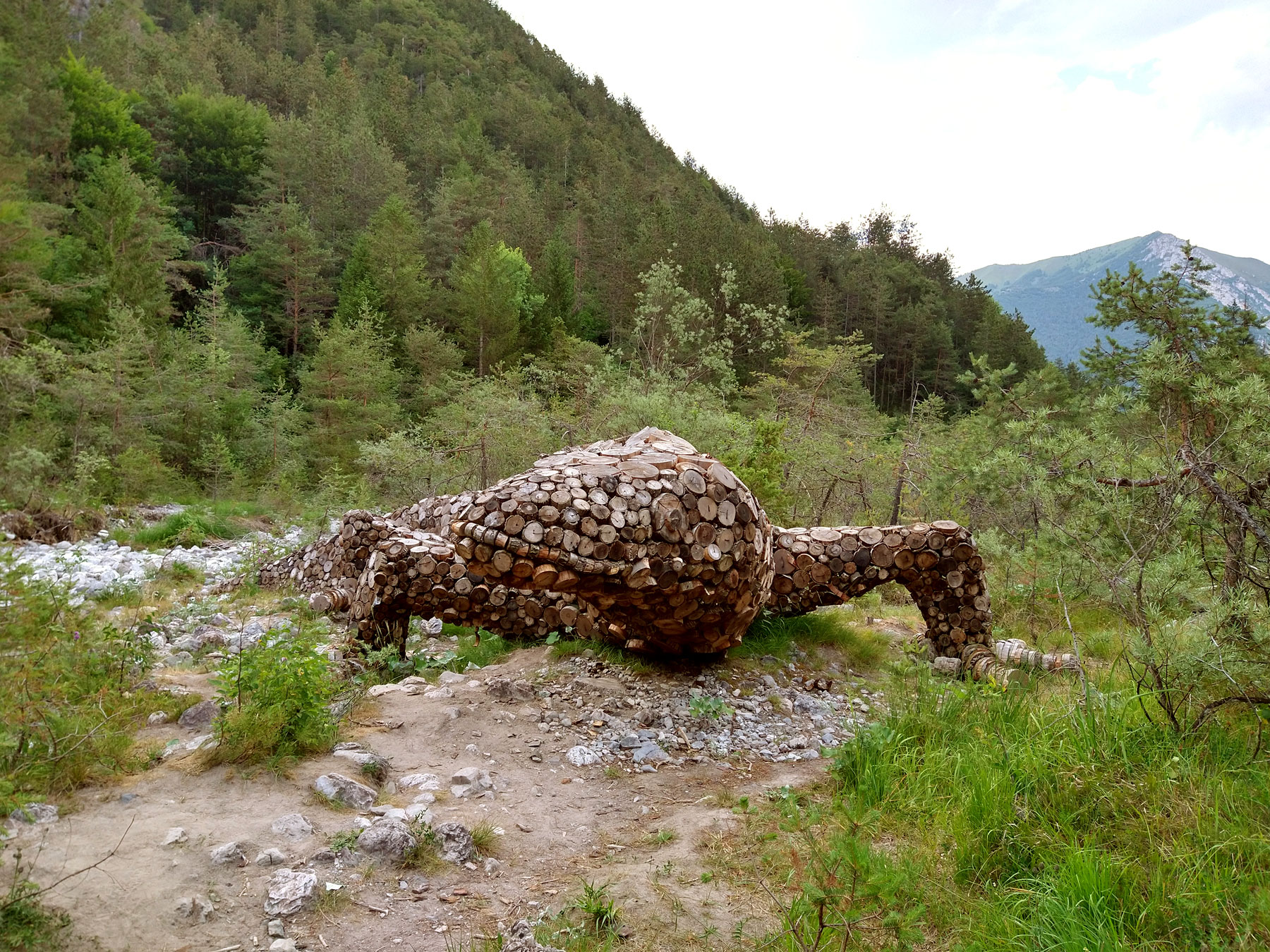 |
| Franz Avancini, Alpine Triton(2020) |
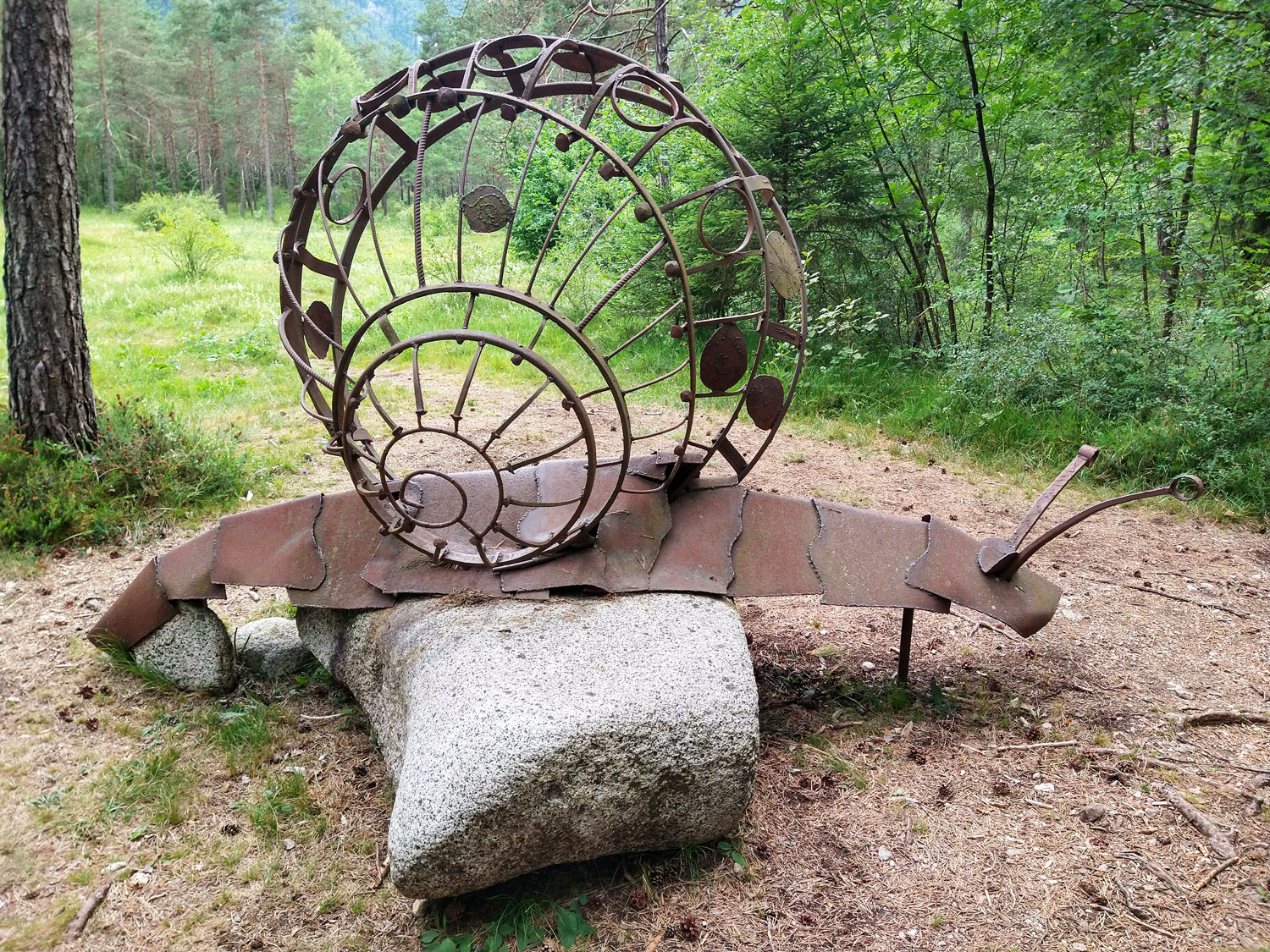 |
| Corrado Rosa, Snail (2012) |
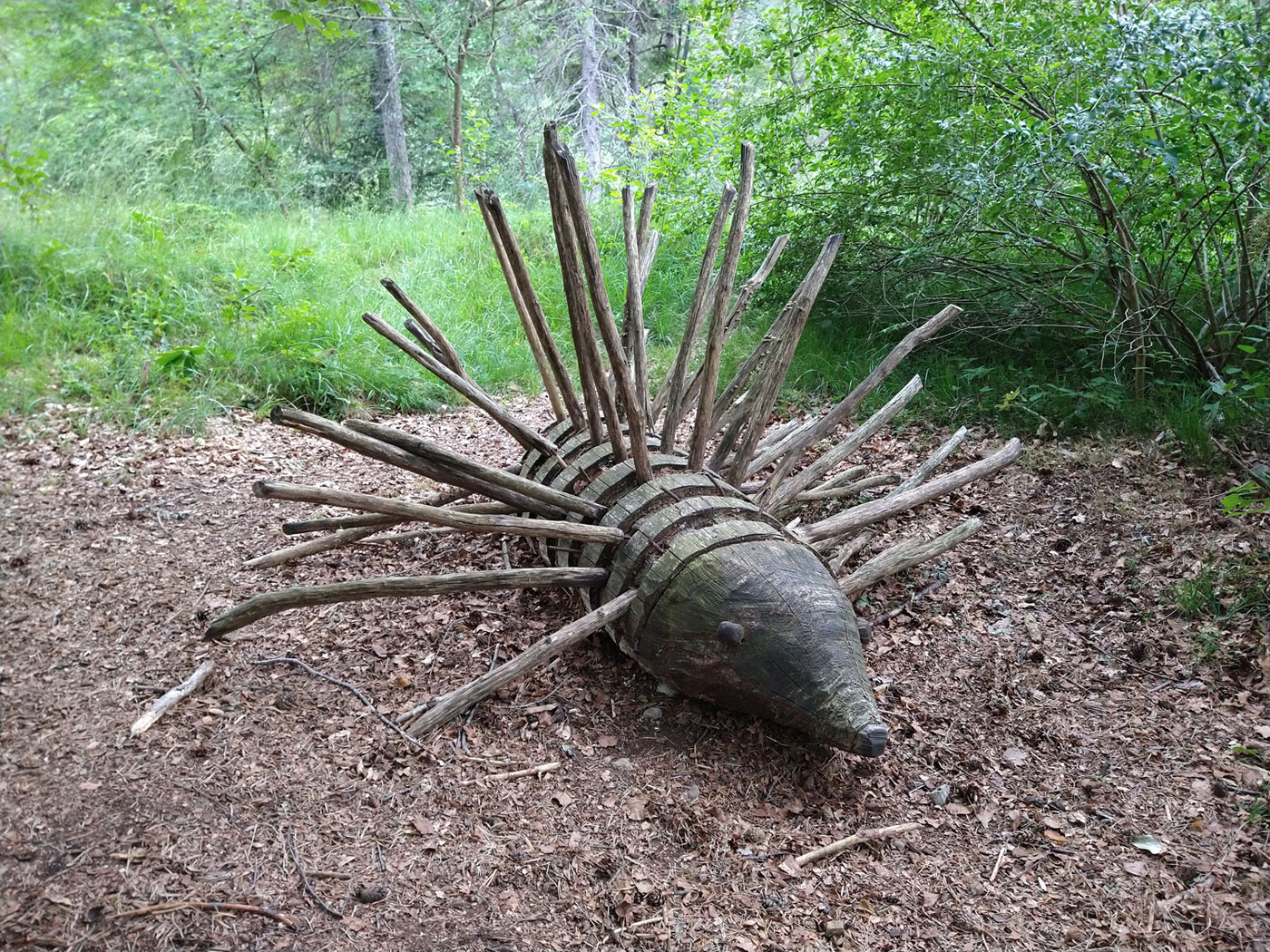 |
| Giampaolo Osele, Hedgehog (2014) |
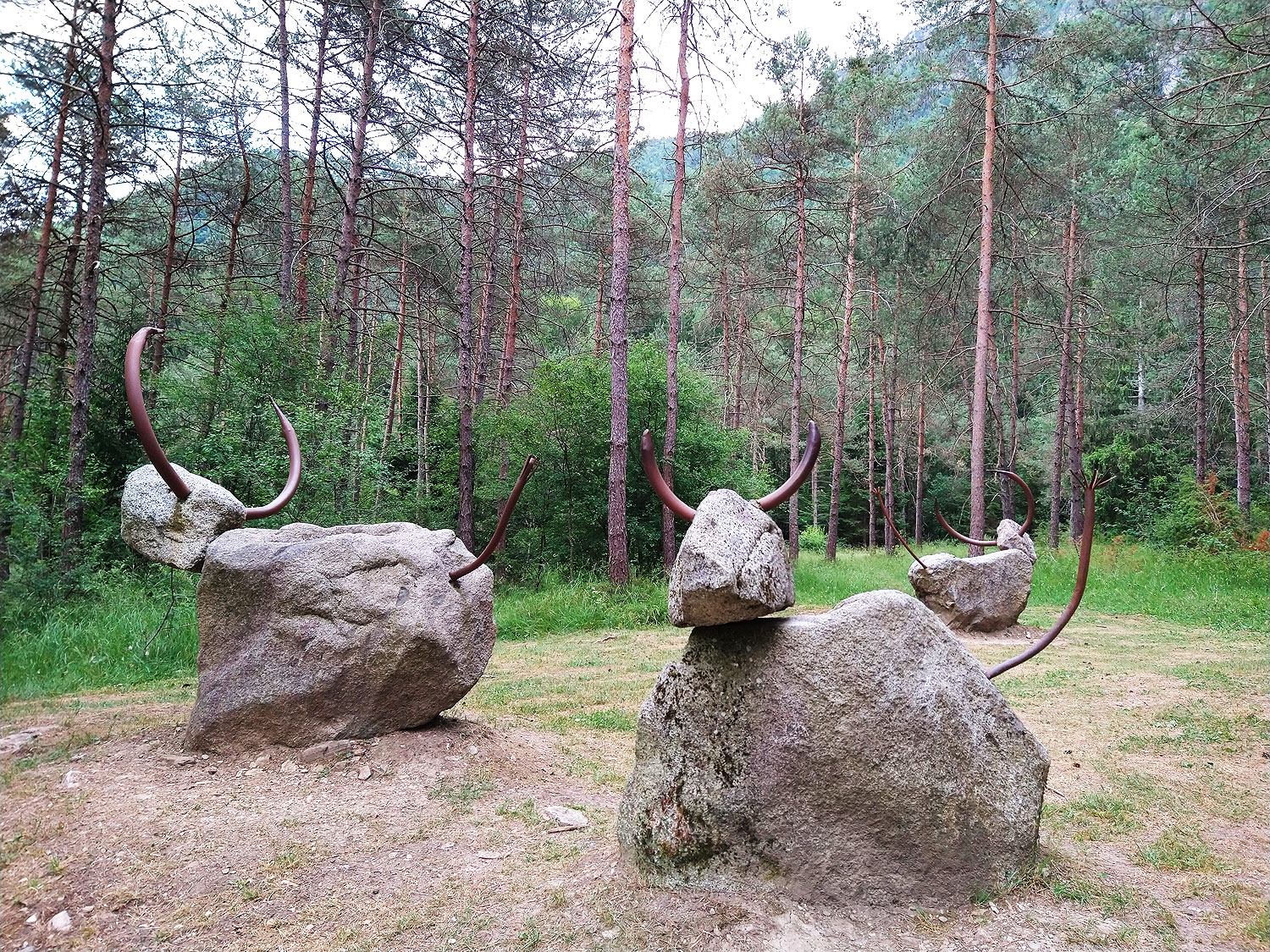 |
| Paolo Vivian, Cow show (2012) |
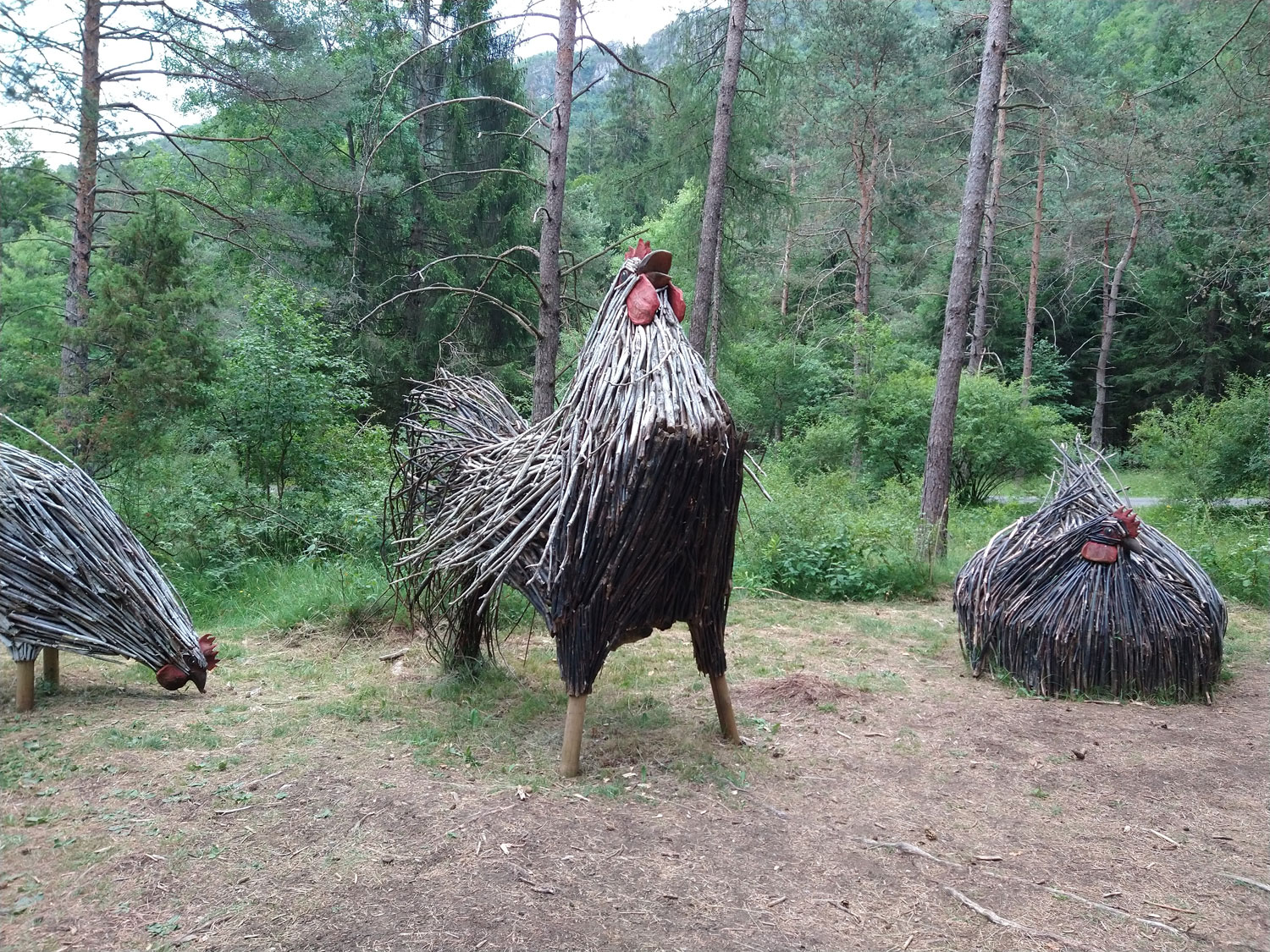 |
| Matteo Cretti, Sign o' the times (2020) |
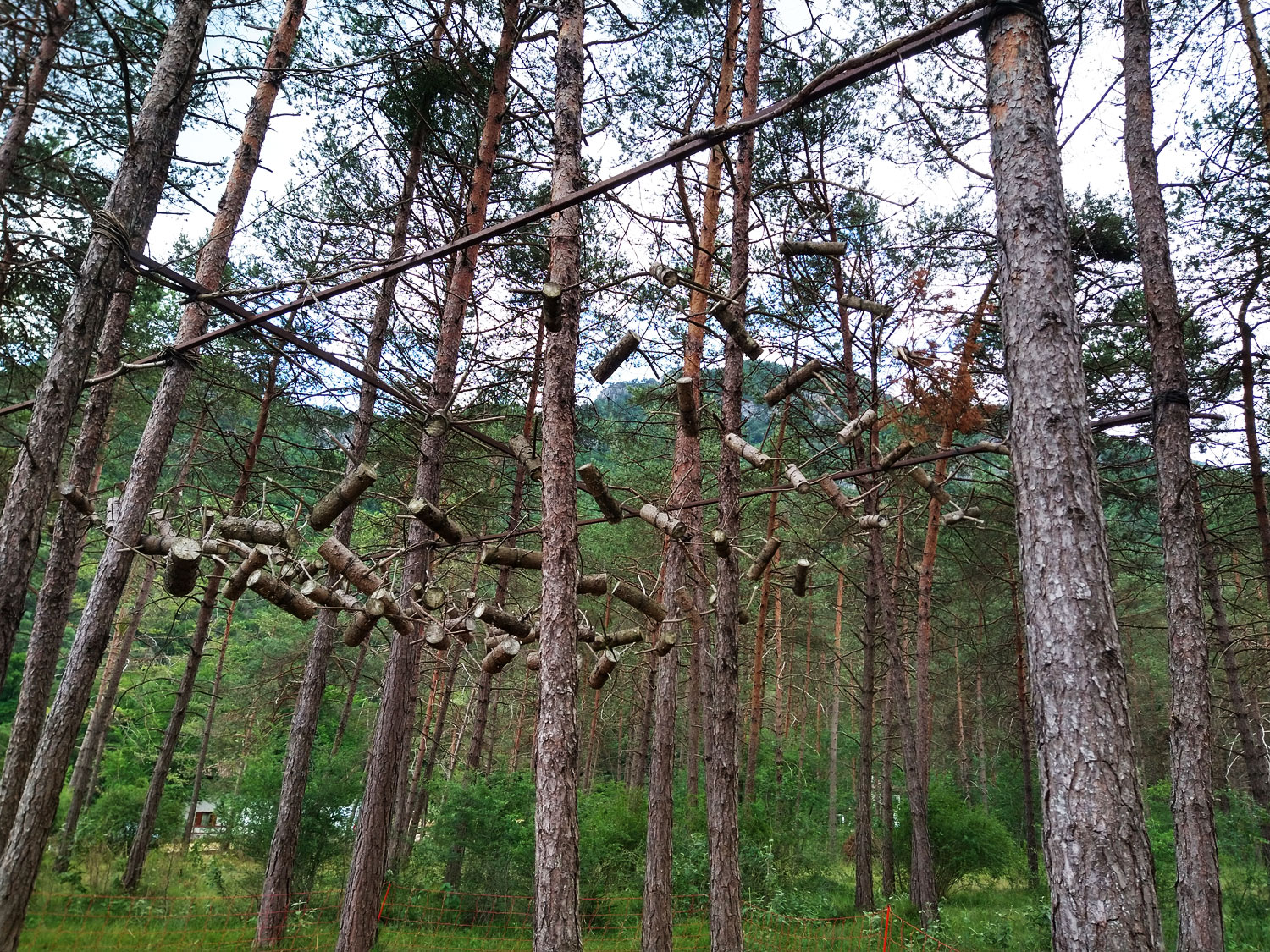 |
| Erika Inger, Rave (2019) |
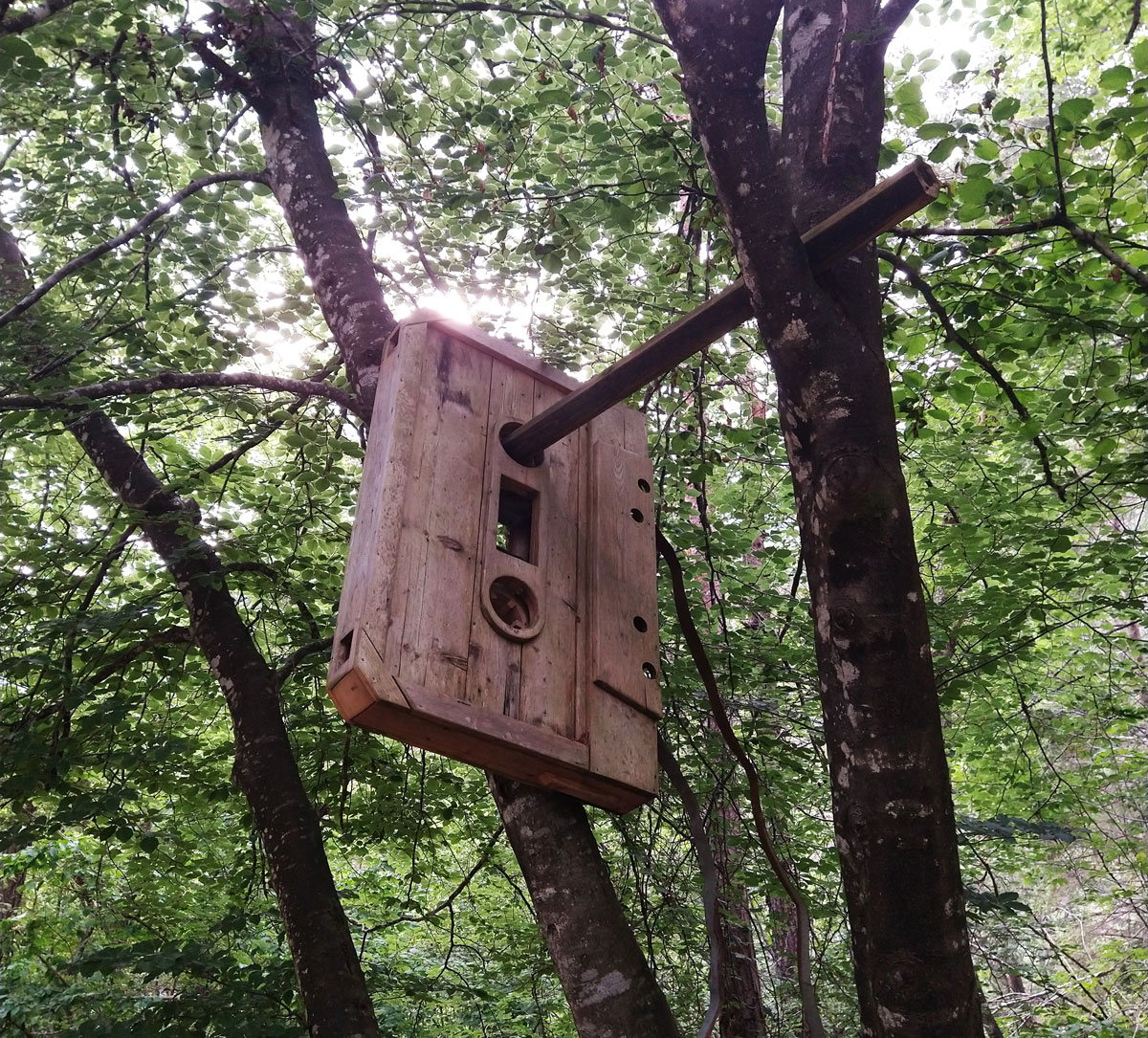 |
| Dan Woodman, Xennials tribute (2018) |
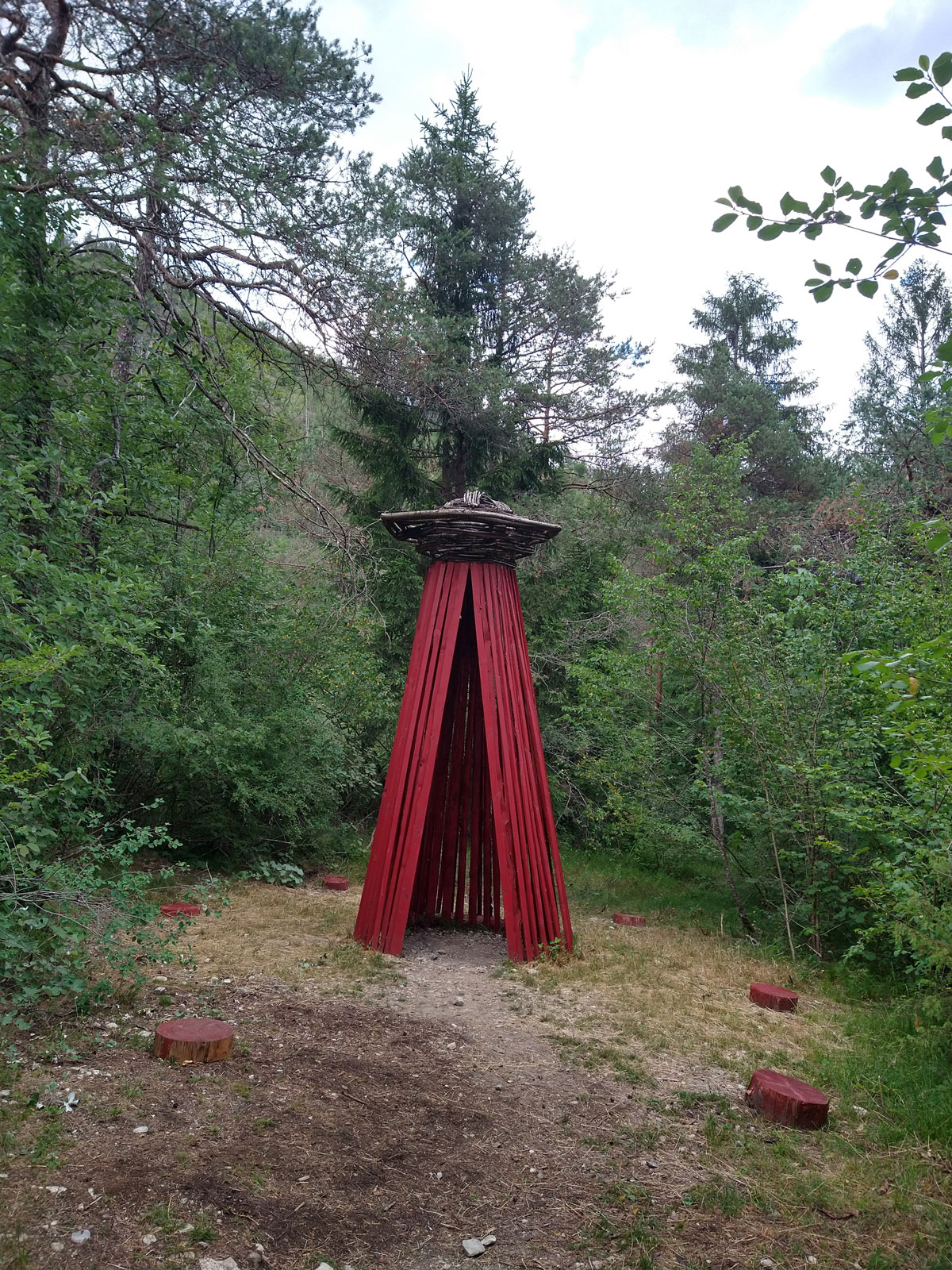 |
| Valerio Cerbella and Luisa Benevieri, Close Encounters (2020) |
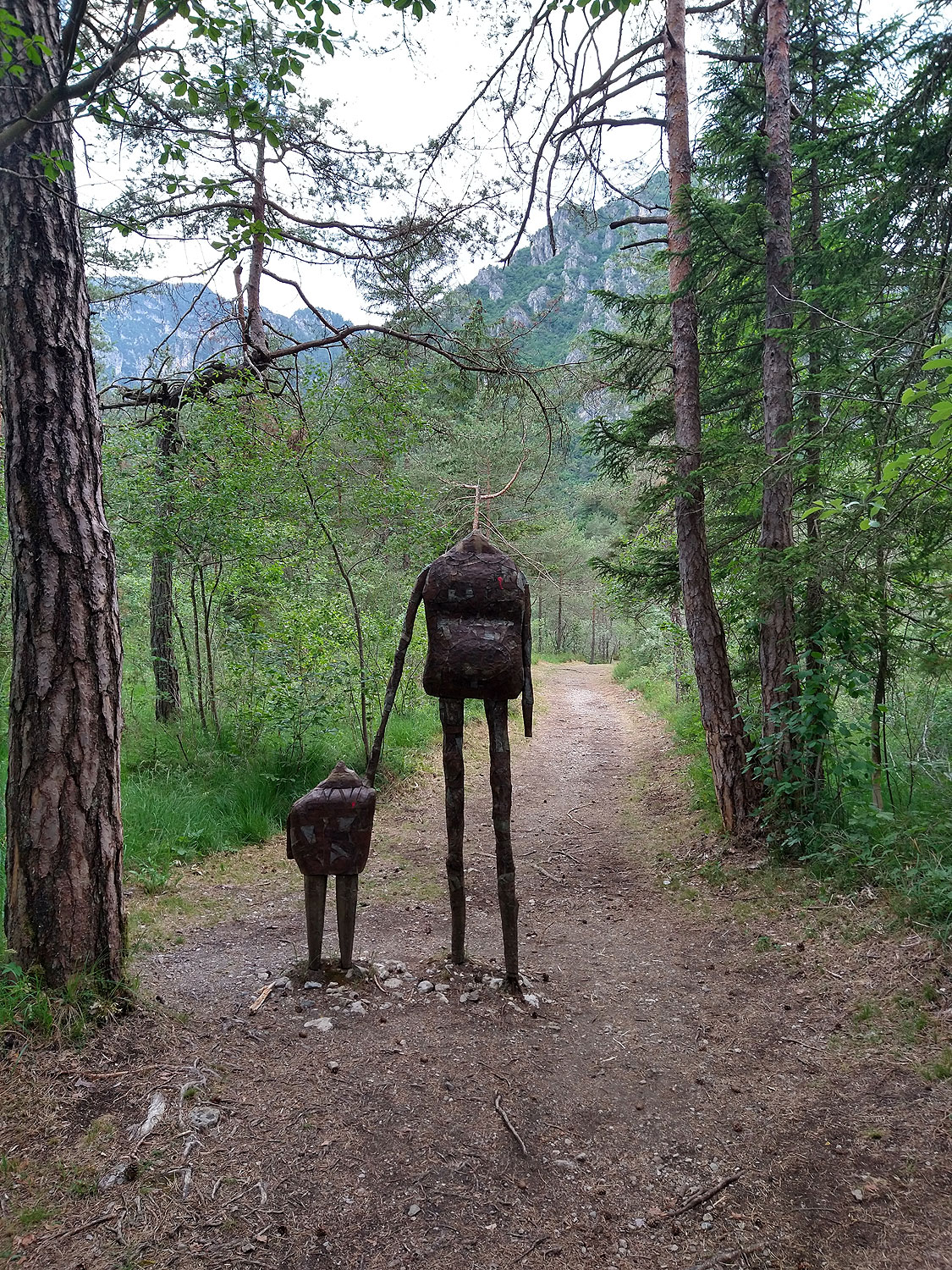 |
| Giovanni Bailoni, The Old Man and the Child (2013) |
There is also a UFO spacecraft in Pur's pine forest: Close Encounters is the work of Giulio Valerio Cerbella and Luisa Benevieri. Taking its cue from the stories that human beings have come into contact with unidentified flying objects, it is intended to remind us of the human nature of people-to-people contact and the responsibility, as well as respect, one must have in dealing with people and nature. Respect and a kind of communication with nature is the theme of Micol Grazioli's work, Faces in the Earth (2013). Casts of faces, masks that sink into the earth, in contact with it: every time visitors look closely at the faces they are "forced" to make a bow, transforming this gesture into a form of respect. This is followed by Trincea (2013), by Roberta Rizzi and Caterina Agazzi: an installation linked to historical memory, but also to the labyrinth; in the first case, nature offers a space of defense, in the second it becomes a space to walk through. After the Sphere (2013) byPietro Gellona and Maurizio Vescovi to symbolize the relationship between architecture and landscape, between art and nature, which only man can realize, four wooden beams like four stylized trees collect the frequencies, waves and vibrations of the surrounding nature: it is theSound Alembic. Also related to the idea of sound is Matteo Boato 's large-scale Violin made of oukumè wood: man-made, it is, however, placed in a natural context. The steel strings of the huge violin can really be made to vibrate, causing the sound to spread through the forest along with the sound of the river flowing nearby. Between the Violin and the Triton , Giovanni Bailoni's Old Man and Child hold hands. The latter walk together through the difficulties of life and together rely on nature; the slow pace of nature is also comparable to the wisdom of the old man. Not far away large Hands, the work of Alessandro Pavone, represent those of the people who lived and worked in this land in the past.
The Witch in the Woods by Viviana Puecher and Michele Filippi is closely connected to the very tall broom, titled Slow Motion, by Plamen Solomonsky. The former is accompanied by a legend written by the artists for the Ledro Valley: the witch becomes the catalyst of the energies present in the forest and returns them to the people who pass through it; the latter is a reminder that the Ledro Valley was also once populated by witches. However, anyone able to use the huge broom creates a trail on the ground along which new flowers can grow.
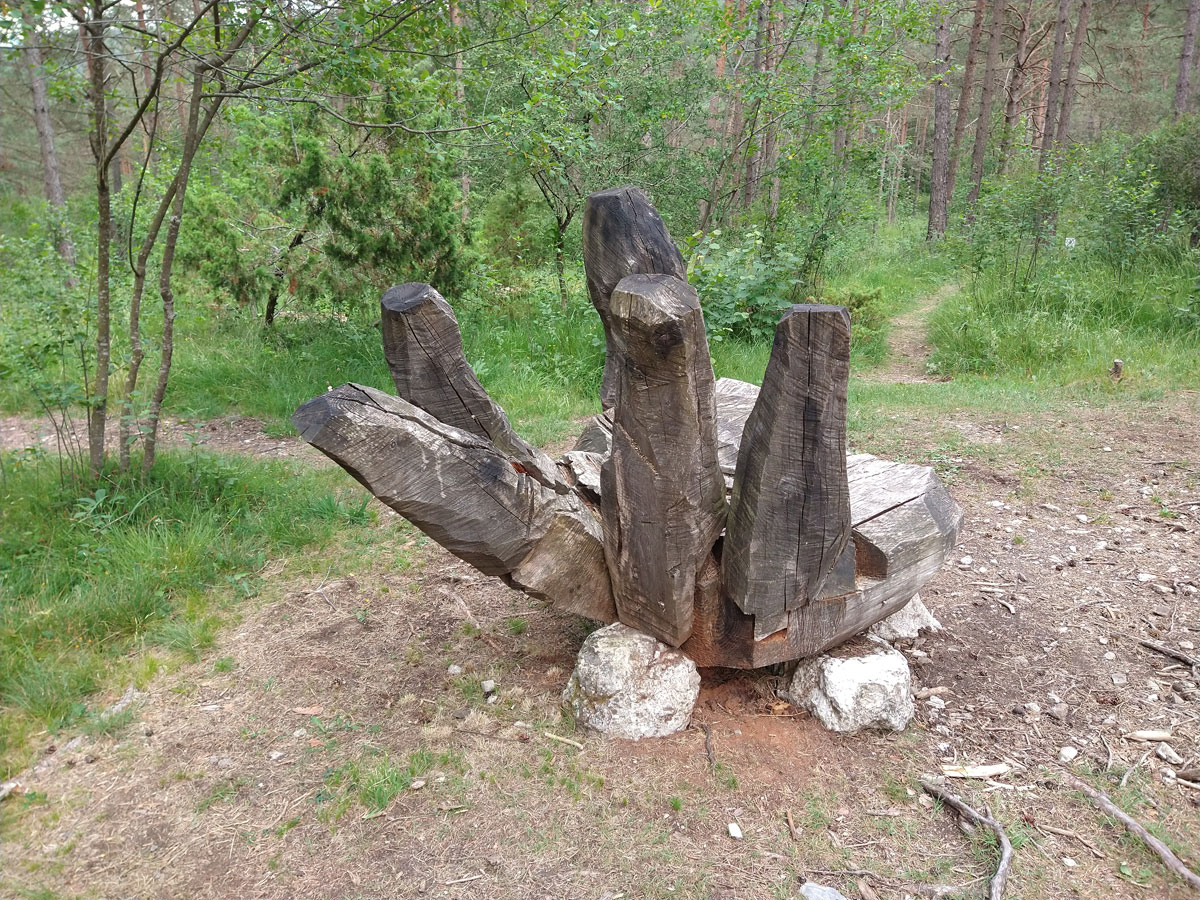 |
| Alessandro Pavone, Hands (2012) |
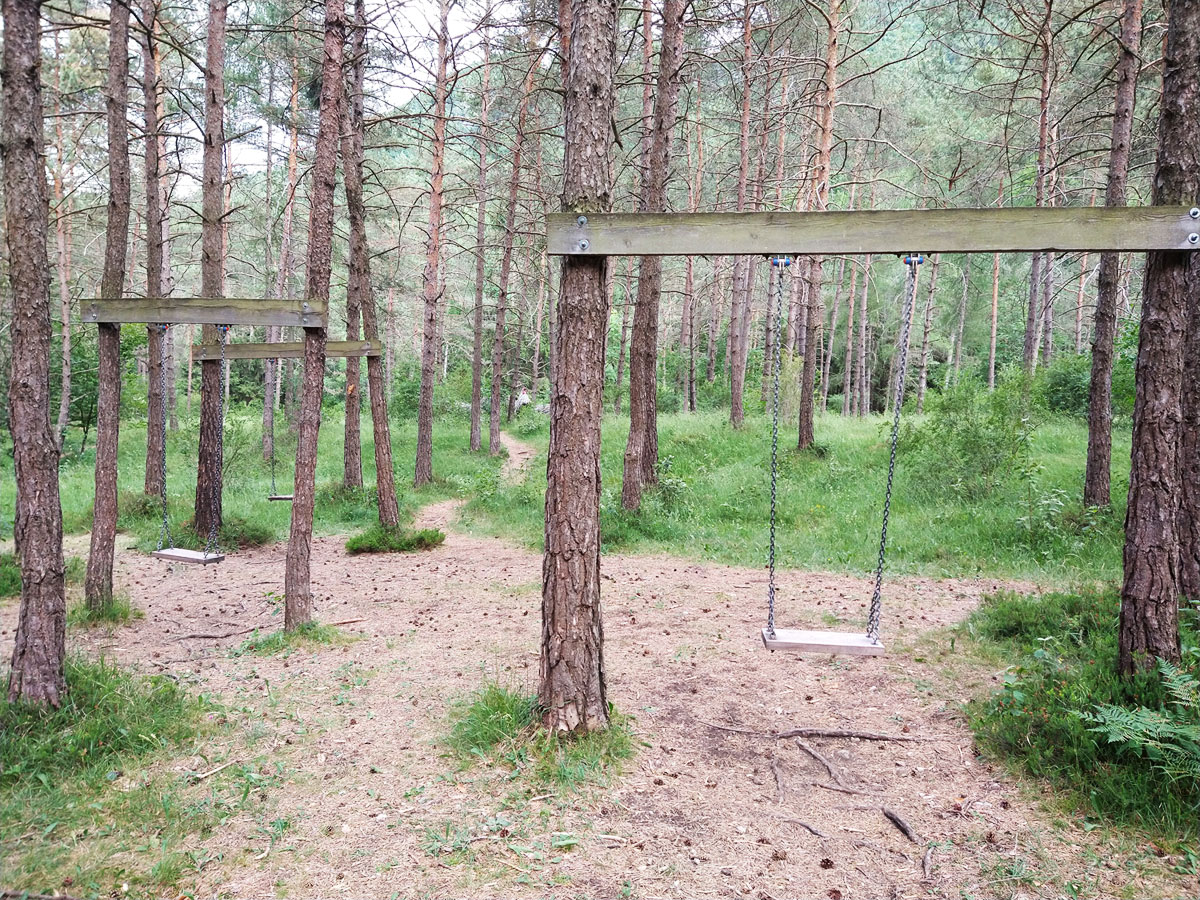 |
| Rossoscuro Design, Swings in the Woods (2012) |
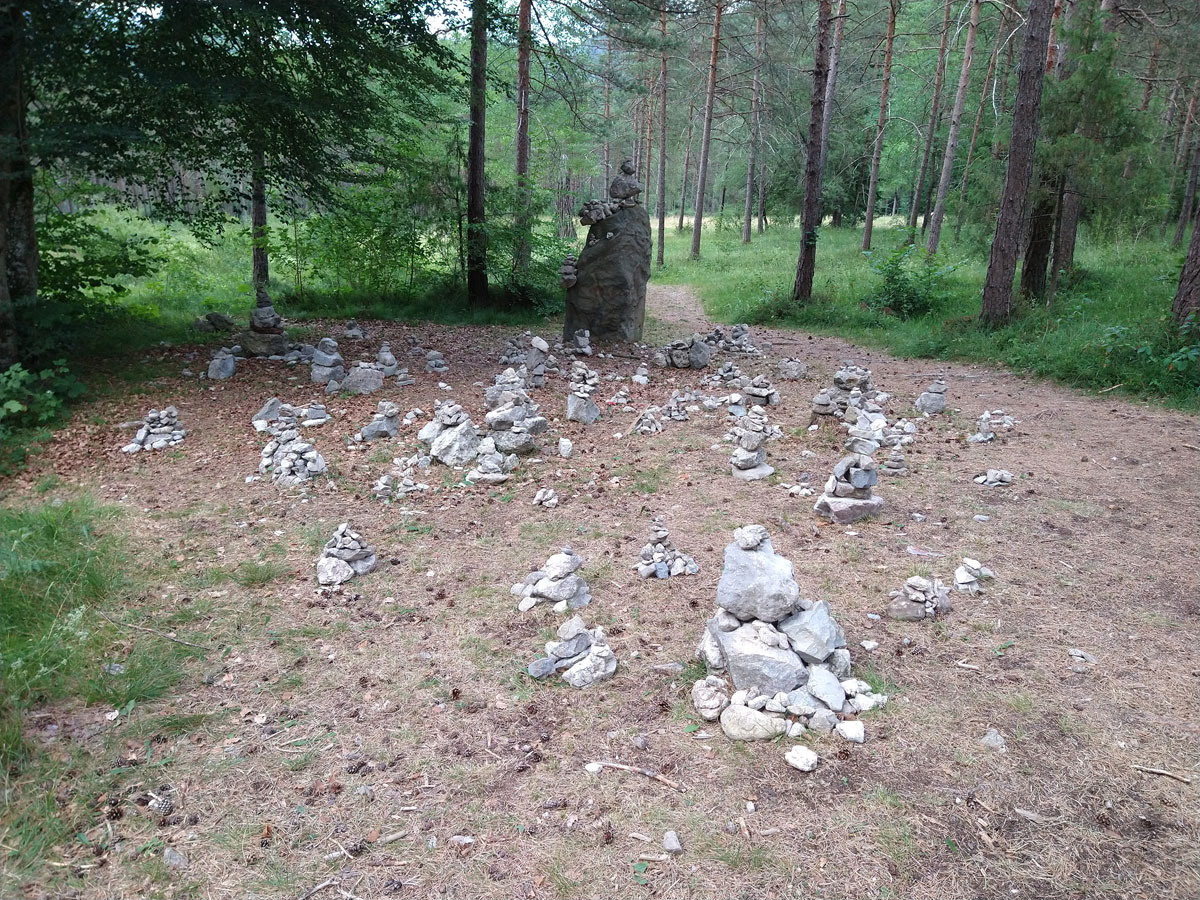 |
| Viviana Puecher and Michele Filippi, Witch in the Woods (2012) |
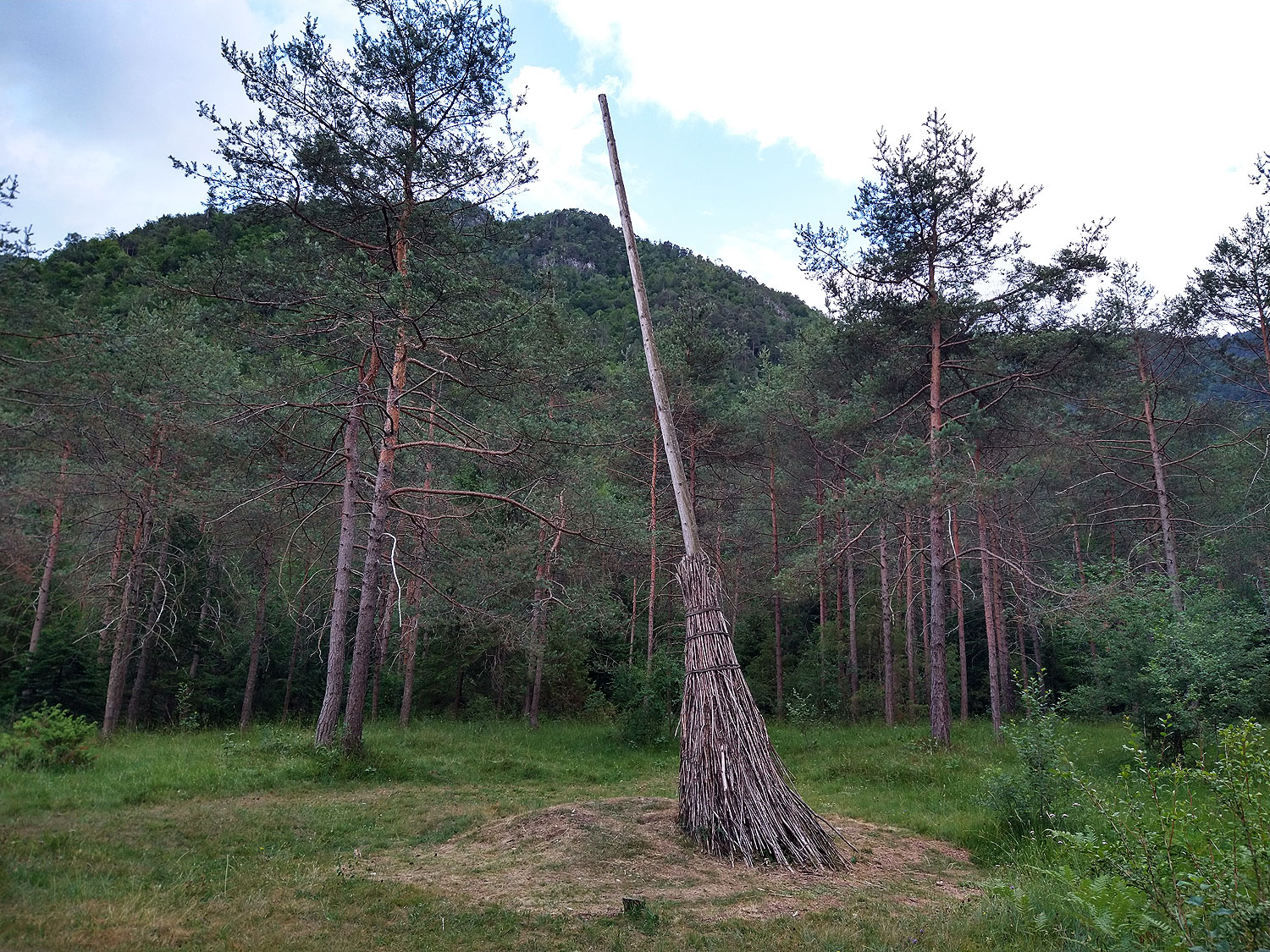 |
| Plamen Solomonsky, Slow motion (2013) |
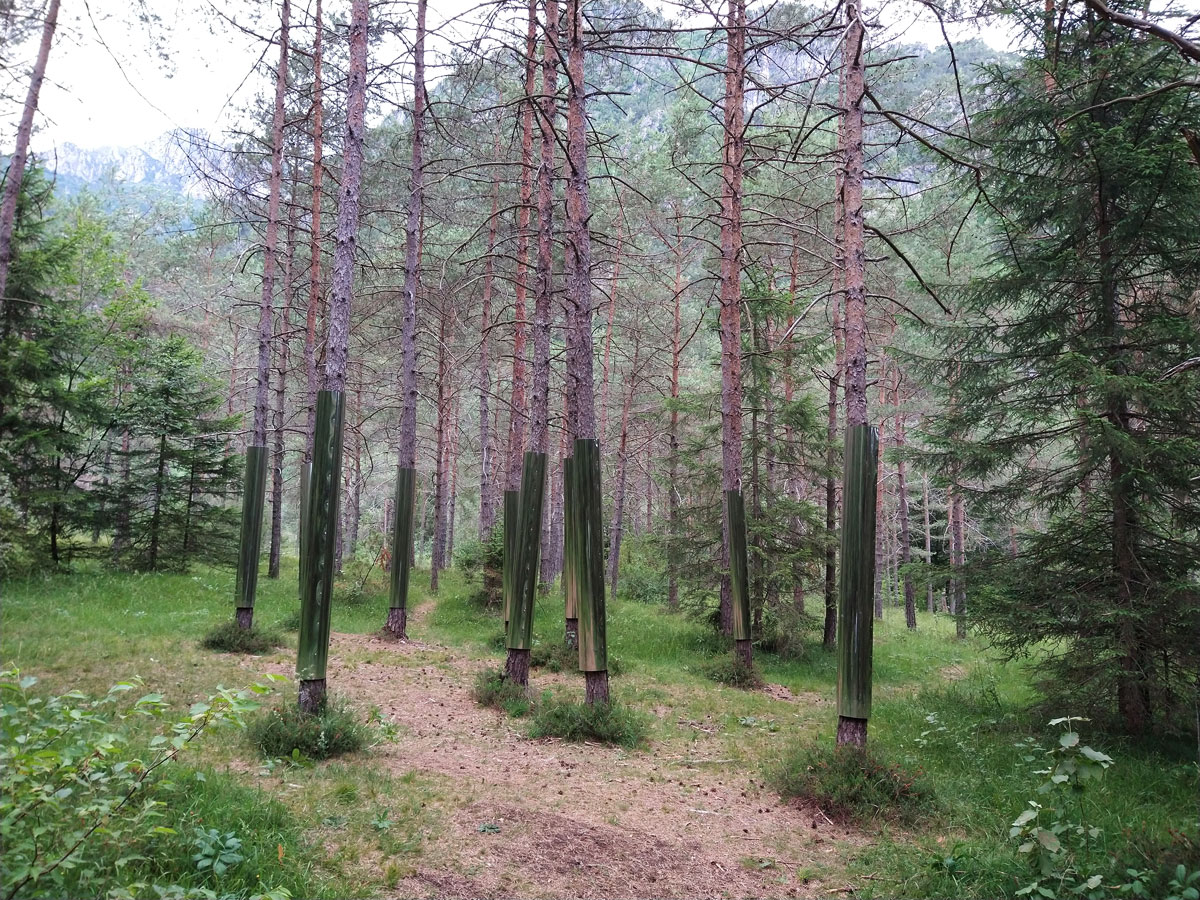 |
| Collective 00, Reflective groove (2019) |
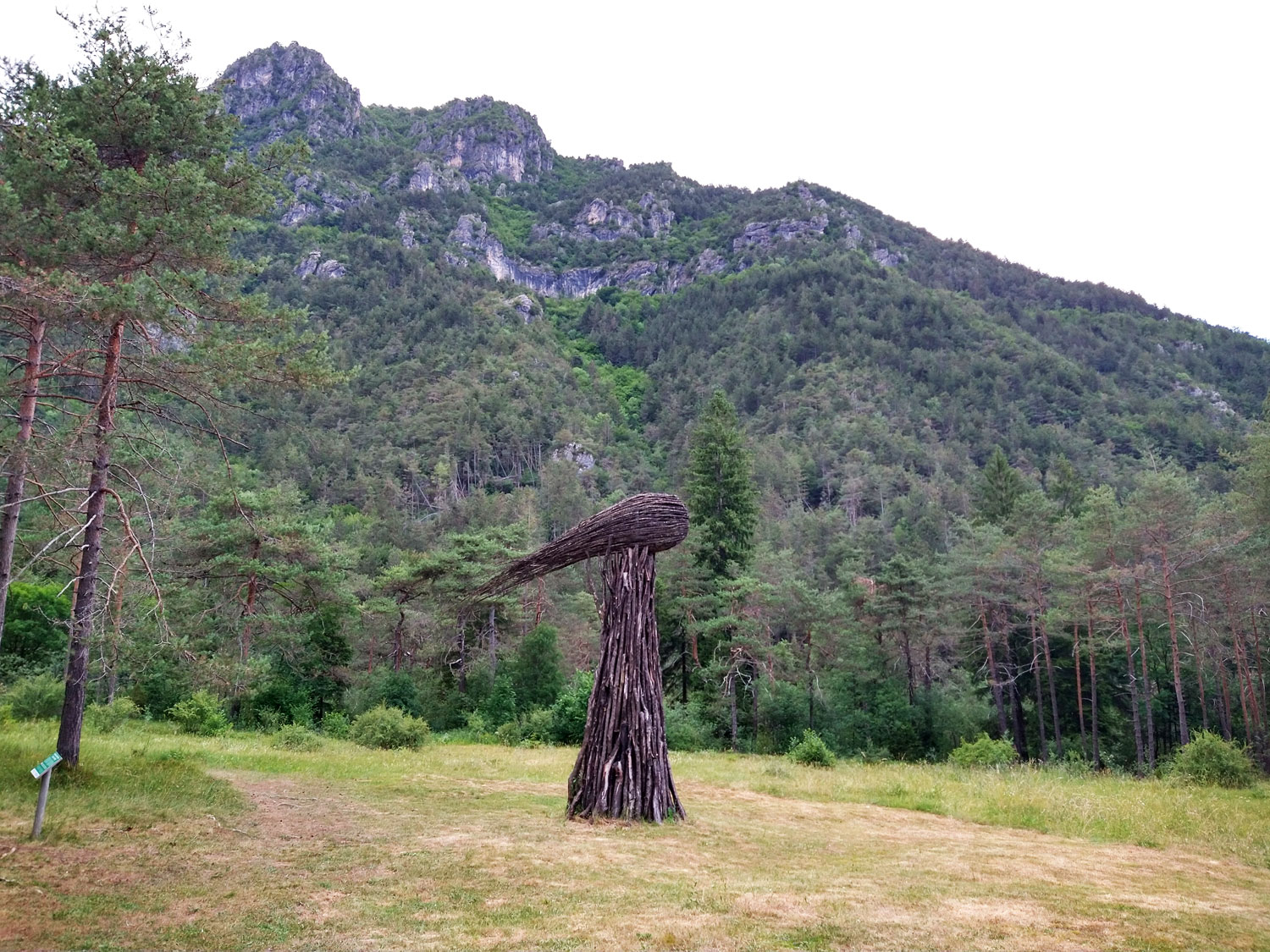 |
| Rumen Dimitrov, Cloud tree (2019) |
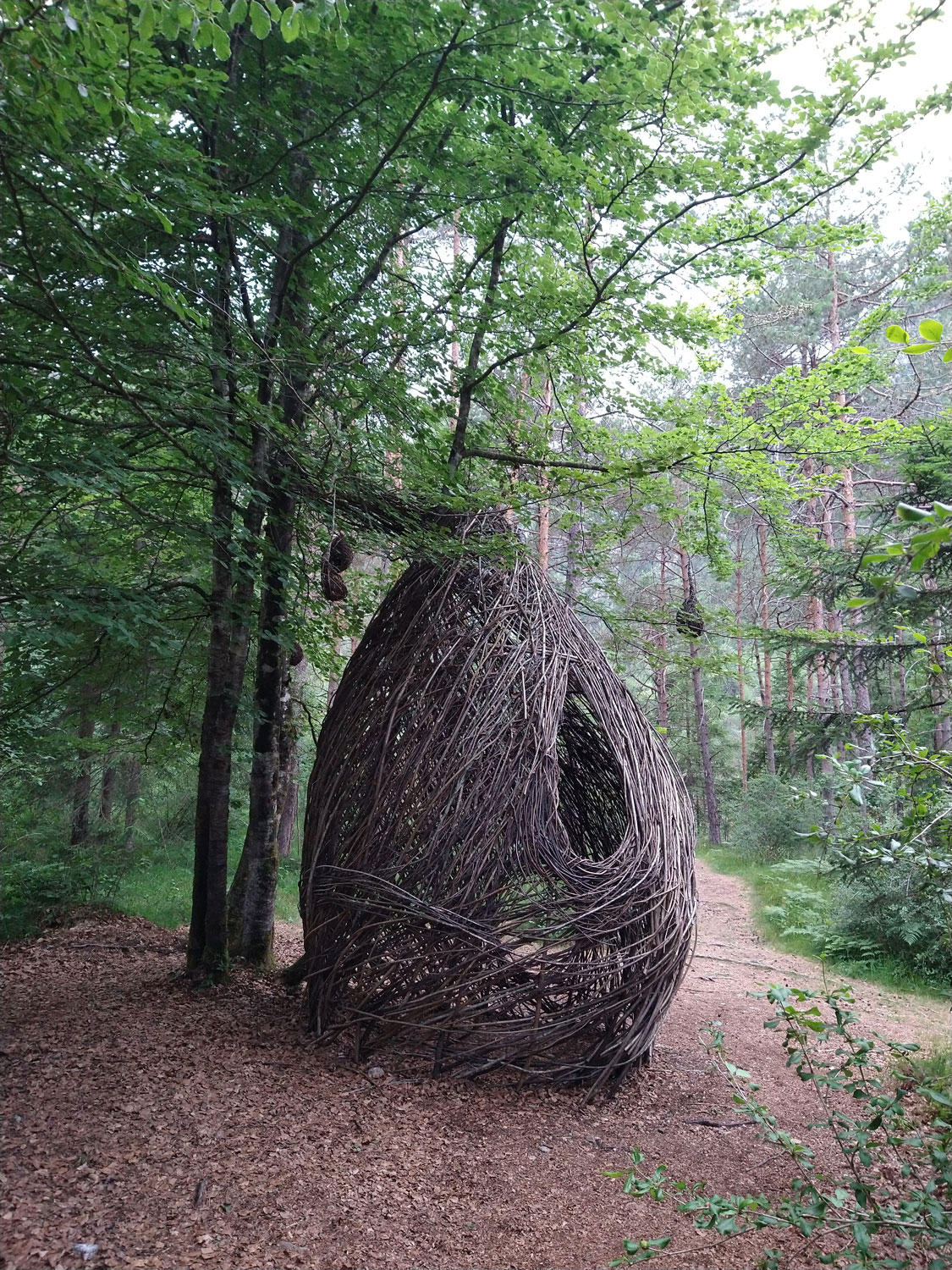 |
| Simone Mulazzani and Valentina Grossi, Anthropoetic volarium |
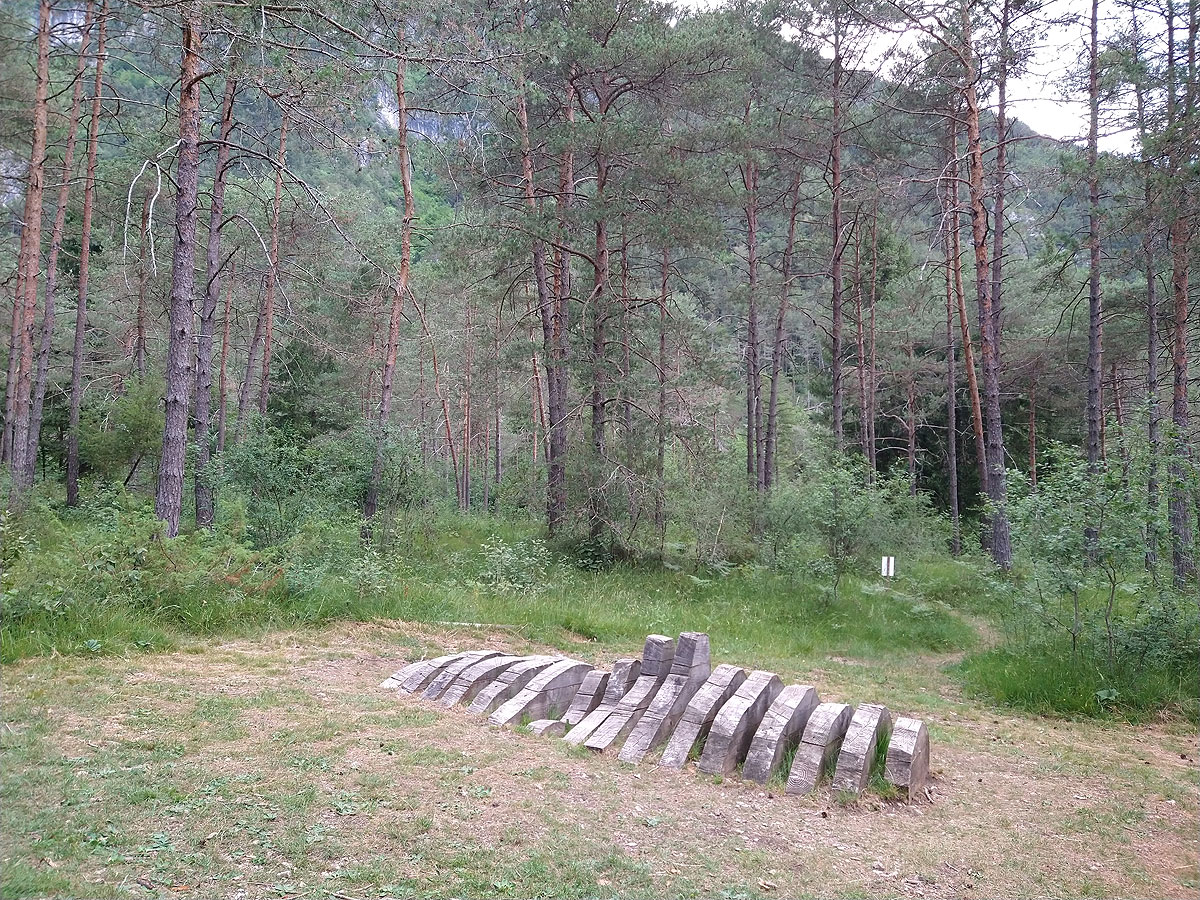 |
| Giordano Faustini, Ruins (2014) |
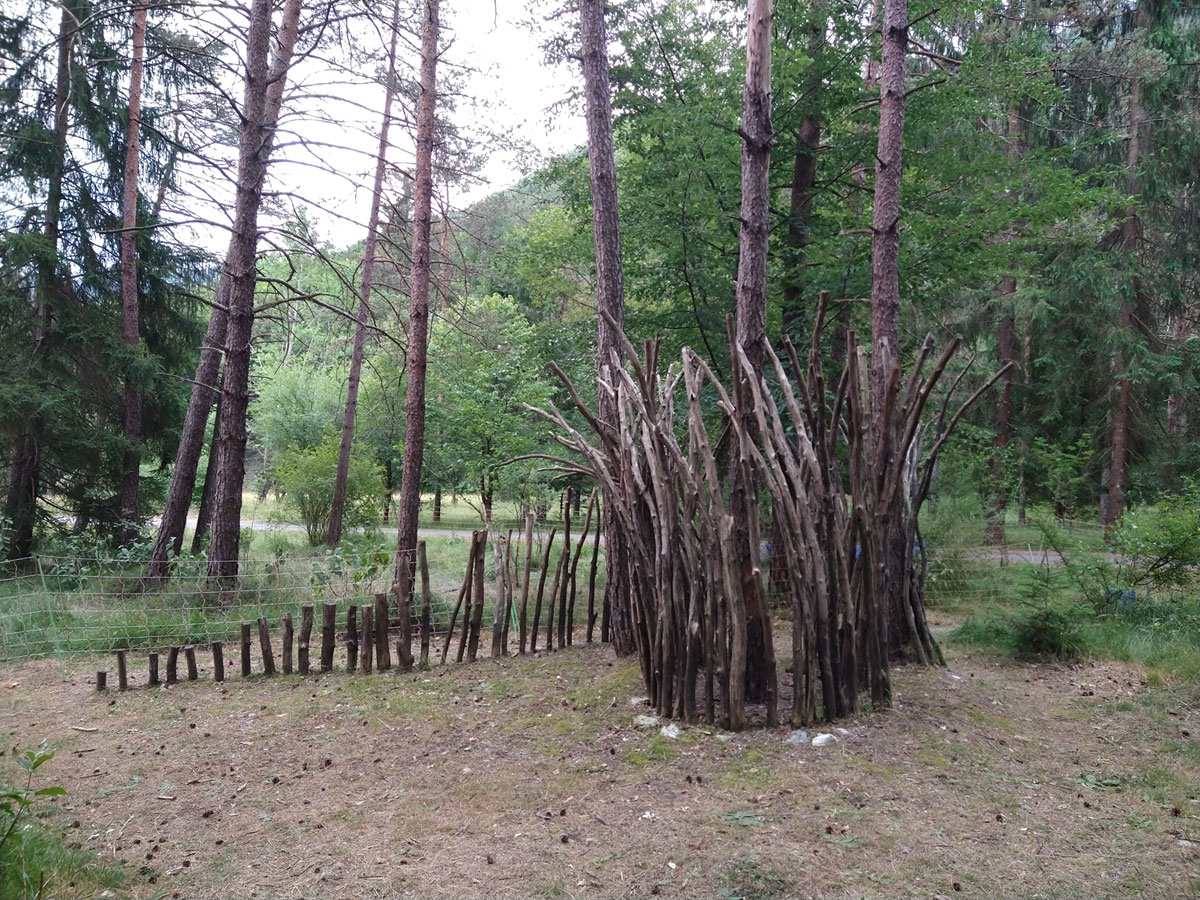 |
| Irene Russo, Black Hug (2017) |
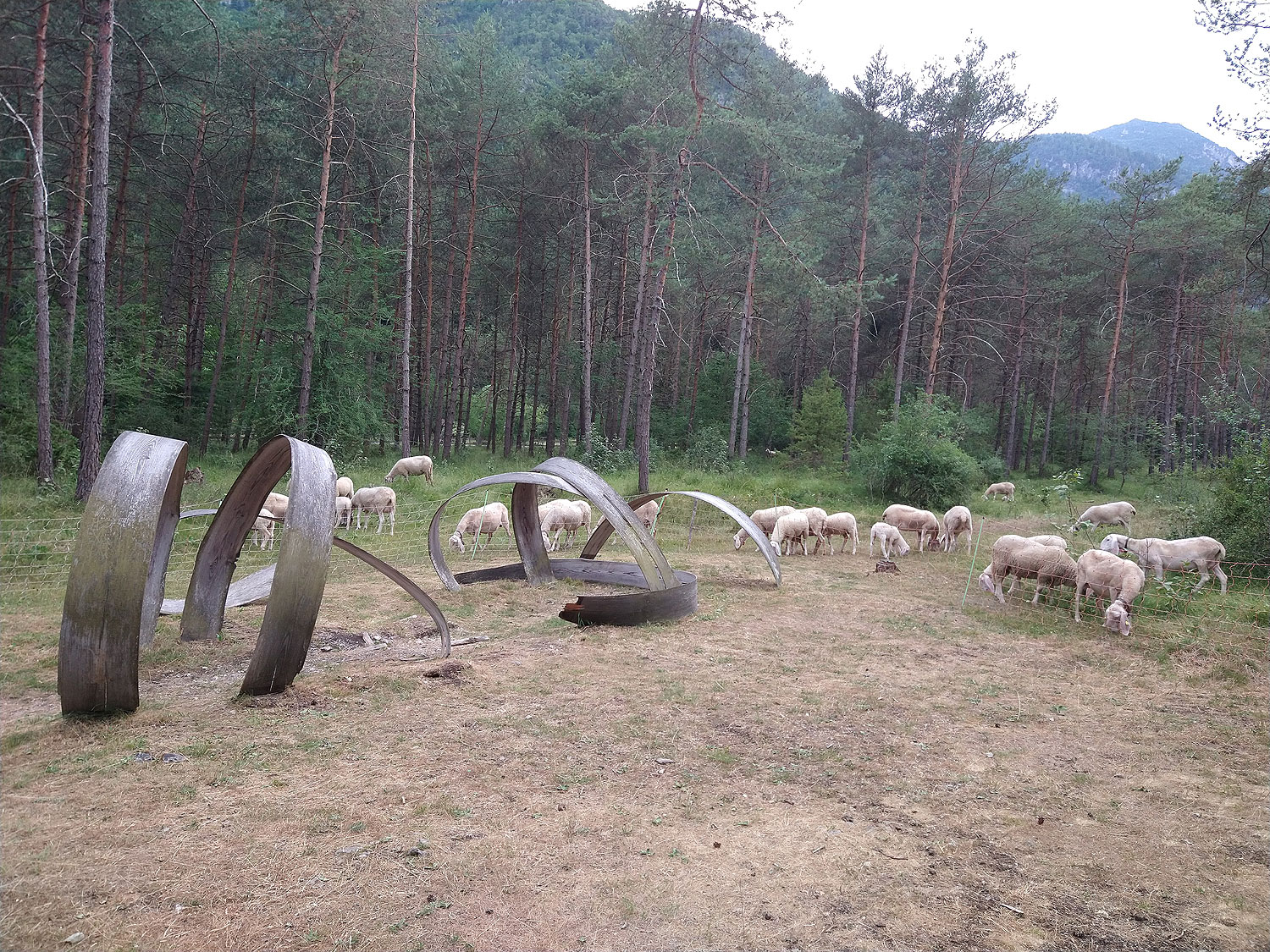 |
| Luca Degara, Wrapped (2012) |
A place of birth and protection and a place to learn to fly in order to soar into infinite space, Simone Mulazzani and Valentina Grossi 's Volario Antropoetico is formed of interweavings of plant matter, of the same matter as the surrounding environment. The Volarium is a place of the imaginary where every act becomes poetic. A metaphor for the creative condition, on the other hand, is Marco Nones' Cone of Shadow: here the individual is free to draw from the unconscious and nature is free to reproduce itself without being tamed. A dreamlike place between people and nature is in fact created by Collective 00's Reflective Groove installation: through mirrored surfaces that wrap the trunks of trees, the perception of space is altered and the boundary between oneself and nature constantly changes.
It is amazing how woods placed almost perpendicular to each other can become a woman with wet hair moved by the wind: this is Cloud Tree by Rumen Dimitrov, a work intended to signify renewal and freedom. Then one encounters the Swings in the Woods (2012) by Rossoscuro Design thanks to which it is possible to be swung between the tall trunks to become children again, in a dreamlike atmosphere. Strongly evocative are Giordano Faustini's Rovine: wooden elements compose a huge face that emerges from the ground, like ancient ruins that the earth lets resurface and that nature wants to possess.
The path concludes with Black Hug, Infinite Limit and Wrapped: the symbolic embrace between man and nature conceived by Irene Russo intends to raise awareness about the arson fires that affect vast territories in Italy, including Campania, the artist's homeland; Leonardo Nava 's Limite infinito also wraps trees in a circular structure that unfolds without interruption, drawing a boundary that is also an opening, in order to understand the infinity of nature; and finally, Avvolto by Luca Degara creates a space where a continuous exchange between light and shadow takes place, as it delimits without totally isolating. Lying on the earth, the structure waits for nature to do with it what it wants.
Thus, one leaves the pine forest of Pur with a greater awareness of how important the human-nature relationship based on respect and sustainability is: the works that one gradually encounters on the way fascinate, make one dream and make everything more magical, but above all lead one to reflect. And this, now more than ever, is needed. To act quickly.



























